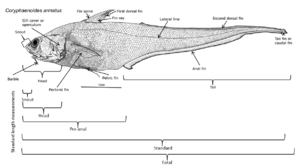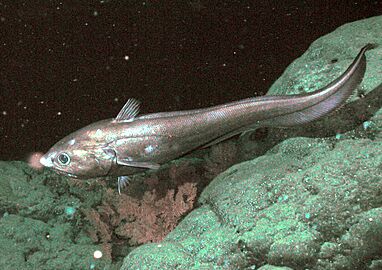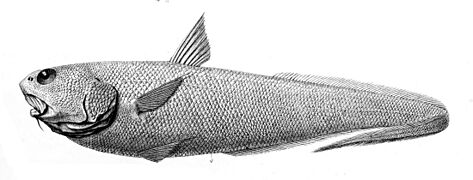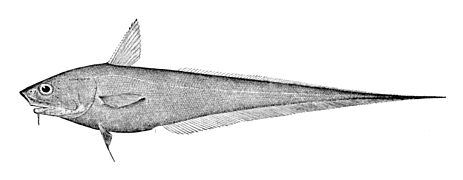Abyssal grenadier facts for kids
Quick facts for kids Abyssal grenadier |
|
|---|---|
 |
|
| Abyssal grenadier, Coryphaenoides armatus | |
| Conservation status | |
| Scientific classification | |
| Synonyms | |
|
The abyssal grenadier, Coryphaenoides armatus, is a fascinating fish that lives in the deepest parts of the ocean. You can find it in all the world's oceans. This fish lives at amazing depths, usually between 800 and 4,000 meters (about half a mile to 2.5 miles) below the surface!
Adult abyssal grenadiers are typically 20 to 40 centimeters (8 to 16 inches) long. Some can even grow up to 1 meter (about 3 feet) long. This fish has a unique body shape. It has two strong spines on its back fin. It also has many soft rays, which are flexible supports for its fins. The abyssal grenadier has a very large head and big eyes. However, its mouth is quite small. Its body is mostly brown, but its belly has a bluish color.
Contents
Where Do Abyssal Grenadiers Live?
The abyssal grenadier, also known as Coryphaenoides armatus, lives on the deep ocean floor. It prefers the upper parts of the continental rise. This is a gently sloping area at the bottom of the ocean. These fish are usually found between 2,000 and 4,700 meters deep. However, they have been seen as shallow as 282 meters and as deep as 5,180 meters.
The exact depth where they live can depend on the ocean. In the Atlantic and Indian Oceans, they live between 2,000 and 4,800 meters. In the Pacific Ocean, they stick to areas with more food. There, they are found between 2,000 and 4,300 meters deep.
What Do Abyssal Grenadiers Eat?
The diet of the abyssal grenadier changes as it grows up. When they are young, they eat small creatures that live on the ocean floor. These include crustaceans like crabs and shrimp, and sea cucumbers. As they get older, their diet changes. Adult abyssal grenadiers hunt bigger prey. They eat fish that live in the middle and deep parts of the ocean. They also eat sea urchins and cephalopods like squid and octopuses.
Scientists have studied how their senses change too. Young grenadiers rely more on their eyesight to find food. But adult grenadiers become very good at smelling. They use their sense of smell to find food in the dark deep sea.
How Do They Find Food?
Abyssal grenadiers mainly eat squid and fish that live in the middle of the ocean. But they can also eat echinoderms, which include sea urchins and starfish. Scientists have looked at the stomach contents of these fish. They found that a lot of their food comes from very deep parts of the ocean.
These fish are mostly meat-eaters. However, they have also been seen eating phytodetritus. This is like "marine snow," which is tiny bits of dead plants and animals that fall from the surface. This happens more often in certain areas. Researchers noticed that these fish swim faster when there is more marine snow. This suggests they are actively looking for these extra nutrients.
Studies show that abyssal grenadiers are smart hunters. They follow a strategy called "optimal foraging theory." This means they try to get the most food with the least amount of energy. They keep their bodies working slowly and use less energy when hunting. This is important because food is scarce in their deep-sea home. It helps them save energy in such a tough environment.
See also
- Grenadiers (fish)
- Coryphaenoides yaquinae





